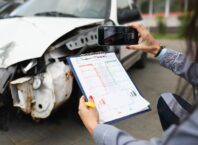In most scenarios where a car and pedestrian collide, it’s the knee jerk reaction to assume the driver was at fault. Maybe they weren’t paying attention to the roads or were driving under the influence of an illegal substance or a prescription medication, but surely those irresponsible people behind the wheel of the moving vehicle had to be the reason that the innocent pedestrian was injured.
But that’s not always the case in every car-pedestrian accident. In the events where the pedestrian was at least partially at fault for the collision, we turn to the law and legalities regarding liability for clear instructions.
Contents
The Driver’s Rights and Responsibilities
Behind the wheel, you take on a role in which you agreed upon obtaining your license to exercise with caution. Every driver has a duty of care to drive carefully and follow the laws and guidelines for safe motor vehicle operation.
This law states that any person driving is to be alert for dangers, such as pedestrians crossing the street or walking on the side of the road. They are to become extra cautious in any area where pedestrians might be nearby and slow down if they see someone walking or on a bike in the vicinity.
Drivers are also not to engage in any activity that would cause them to be distracted from the road and the surrounding area in and around them. Even a slight half-second distraction could be enough to miss seeing a pedestrian in front of them and cause an accident.
Pedestrians Rights and Responsibilities
Yes, pedestrians get the right of way, but they also have a duty of care to perform. Pedestrians and bicyclists should know the law and walk on the correct side of the road. They should use sidewalks when available and cross at crosswalks. Horseplay should never be attempted if there are cars nearby.
Pedestrians are required to follow the rules of the road and obey all traffic and road signals and signs. When they don’t, it’s possible for a pedestrian or bicyclist to be ticketed or cause an accident in which they are held liable.
When a Pedestrian is At Fault
Occasionally, the actions of pedestrians make it virtually impossible to avoid hitting them, no matter how cautious the driver is. In these circumstances, the jury or judge in a lawsuit will find the pedestrian guilty for causing the accident.
Sometimes the pedestrian is completely at fault, like if they were walking in the middle of the road at night in dark clothing or if they jumped in front of a car. In circumstances like those, the pedestrian can be held liable for all damages to the vehicle and any personal injuries incurred, including those that may have happened if the driver tried to avoid hitting the person and instead hit another vehicle.
What if Both the Pedestrian and the Driver are At Fault?
There are also cases in which the fault lines are blurred. Maybe the pedestrian did contribute to the accident by not being careful, but the driver also wasn’t paying attention and could have avoided the collision. In those cases, both the driver and the pedestrian could be held liable for some portion of the damages.
For these situations, each state has its own way of handling the liability. Some states require each party to pay the percentage in which they are guilty of contributing to the accident, as determined by a jury. Other states determine that once a party was more than 50% responsible for the collision, they are the at-fault party and must pay for the full damages. This is called comparative and contributory fault in personal injury language.
To be determined at fault for an accident, it has to be proven that you were negligent in your actions. This happens when you don’t exercise reasonable care in what you are doing, as when you are driving distractedly or jaywalking in front of busy oncoming traffic.
In a state where the comparative negligence system is used, if you are at partial fault, you can’t collect the full damages that are awarded to you. If the contributory negligence system is used, if you were deemed negligent at all, you cannot collect any damages whatsoever.
Since each state views comparative and contributory negligence differently, it’s important to understand the five Doctrines of Negligence:
- Contributory negligence occurs when you are judged to have contributed at all to an accident. With even the slightest amount of contributory negligence, you can’t sue for damages, even if the other party is predominantly at fault.
- Pure comparative negligence says that no matter who is at fault, both or all parties can sue for damages. At the end, whatever the final award is will be divided between all of the parties based on their portion of fault.
- Modified comparative negligence – Also called the 50 Percent Rule, this doctrine states that if you are 50% or more responsible for an accident, you cannot collect any damages awarded for injuries sustained in the collision.
- Modified comparative negligence (51%) – As in the 50 Percent Rule but modified to 51%, you cannot collect any damages awarded for injuries sustained in an accident if you are 51% or more at fault.
- Slight vs. gross comparative negligence – Damages are only awarded if you are considered to be “slightly negligent” in comparison to the other party.
With these doctrines followed by most states, it’s important to have a knowledgeable car accident lawyer when you are in a car-pedestrian accident. It’s easy to see where the burden of proof is integral in showing your innocence regarding the fault of your collision.
The Driver is Not Always Wrong
A common mentality is that the driver of the big vehicle should have been able to avoid the poor pedestrian minding their own business. But the truth isn’t always so black and white. Sometimes the accident is the driver’s fault, sometimes it’s the pedestrian’s, and sometimes it is both.
It’s important to know all of the facts and see all of the evidence before making a judgment, and if you were in a pedestrian-car collision, it’s crucial that you have an attorney who can gather all of this for you and prove the other party’s liability.












